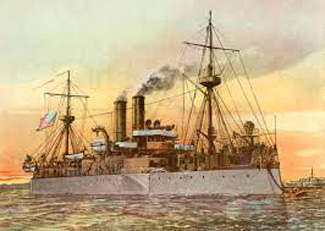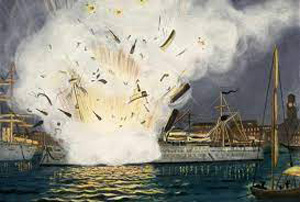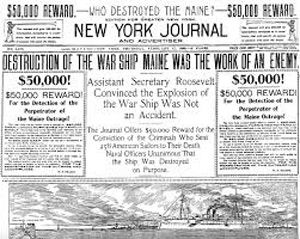The Ship That Sparked a War

The USS Maine was a stately looking vessel. Credit: National Archives
The battleship Maine, docked in Havana, Cuba, harbor February 1898, sank when an interior explosion sent it to the bottom. Spain was blamed but there was no sabotage. Yet it sparked a war.
To get a background of the war we go back over 20 years. Until about 1860, American expansionists had hoped to acquire Cuba. After the Civil War, interest in annexation dwindled, but Americans continued to be displeased by Spanish misrule. A long and exhausting uprising took place in the 1870’s. In 1895, during a depression that made conditions worse, a revolution broke out and again threatened to go on endlessly. The Spanish forces were not powerful enough to put down the insurrection, and the rebels were not strong enough to win.
American newspapers, especially the “yellow press” of William Randolph Hearst and Joseph Pulitzer, printed sensational accounts of Spanish oppression, and carried seriously exaggerated reports that a quarter of the population had died. They continually agitated for intervention. Many Americans regarded conditions in Cuba as intolerable and began to demand that the United States intervene. A few felt that the United States should also acquire naval and military bases and become an imperial power.
In November 1897, President William McKinley pressured Spain into granting Cuba limited self-government within the Spanish empire. The rebels wanted nothing less than independence, and continued to fight. Meanwhile, pro-Spanish mobs in Havana rioted to protest against self-government. To protect Americans from the rioters, the battleship Maine arrived in Havana harbor January 25, 1898. On February 15, and explosion blew up the ship and killed about 260 persons on board. The outraged American public immediately blamed Spain for the explosion, but today many historians believe it was accidental and occurred inside the ship.

The ship exploded from the inside. Credit: U.S. Navy
The first important battle of the war took place in the Philippines. The Asiatic Squadron of six ships under Commodore George Dewey sailed from Hong Kong to Manila Bay. On May 1, 1898, it destroyed the entire Spanish fleet of 10 vessels without the loss of an American life or serious damage to any American ship. Dewey then blockaded Manila harbor while he waited for US troops to arrive.
Meanwhile, the North Atlantic Squadron under Rear Admiral William Sampson had begun a partial blockade of Cuba while searching the Caribbean Sea for a fleet that had left Spain under Admiral Pascual Cervera. Finally, on May 28, American ships located Cervera’s fleet, which had anchored in the landlocked harbor of Santiago de Cuba, on the southeastern part of the island. While the navy placed a blockading force outside the harbor, the army hastily prepared to send an expeditionary force to assault Santiago.
On June 22, Major General William Shafter began landing 15,000 troops at Daiquiri and Siboney near Santiago. The Spaniards offered little resistance during the landing. Joyful newspaper reports of this helped make celebrities of the Rough Riders Regiment and its commanders, Colonel Leonard Wood and Lieutenant Colonel Theodore Roosevelt, the future president of the United States.
General Shafter launched a full-scale two-pronged assault against Santiago on July 1. He sent nearly half of his men against a small Spanish force defending a stone fort at El Caney. The remainder made a frontal assault on the main Spanish defenses at Kettle Hill and San Juan Hills. By nightfall, the Americans had taken the ridges commanding Santiago, but they suffered 1,600 casualties.
As soon as Santiago came under siege, the governor of Cuba ordered Admiral Cervera to run the naval blockade to try to save his ships. Cervera led the ships out on July 3, sailing in single file westward along the Cuban coast. The pursuing American naval vessels, commanded by Commodore Winfield Schley, sank or forced the beaching of all of them. Again, there was no serious damage to American vessels.

Headlines blamed Spanish sabotage. Credit: U.S. Navy
Sentiments grew within the United States to keep the spoils of war, except for Cuba. In the Treaty of Paris, signed December 10, 1898, Spain granted Cuba its freedom and ceded Guam, Puerto Rico and the Philippines to the United States. The United States, in turn, paid Spain $420 million for the Philippines.
The United States had to put down a long and bloody insurrection in the Philippines, strengthened its defenses, built more powerful battleships and reorganized the army to remedy serious weaknesses revealed by the war. The war also showed the need for a canal through the Isthmus of Panama, which separated the Caribbean Sea from the Pacific Ocean. Hence, the Spanish-American War led to the building of the Panama Canal. The battleship Maine, still sunk in the harbor during the war, was raised and sailed again.
Author: Ellsworth Boyd
Ellsworth Boyd, Professor Emeritus, College of Education, Towson University, Towson, Maryland, pursues an avocation of diving and writing. He has published articles and photo’s in every major dive magazine in the US., Canada, and half a dozen foreign countries. An authority on shipwrecks, Ellsworth has received thousands of letters and e-mails from divers throughout the world who responded to his Wreck Facts column in Sport Diver Magazine. When he’s not writing, or diving, Ellsworth appears as a featured speaker at maritime symposiums in Los Angeles, Houston, Chicago, Ft. Lauderdale, New York and Philadelphia. “Romance & Mystery: Sunken Treasures of the Lost Galleons,” is one of his most popular talks. A pioneer in the sport, Ellsworth was inducted into the International Legends of Diving in 2013.
2 Comments
Submit a Comment
All Rights Reserved © | National Underwater and Marine Agency
All Rights Reserved © | National Underwater and Marine Agency
Web Design by Floyd Dog Design
Web Design by Floyd Dog Design

Very interesting article about several components of the Spanish American War. Your history lesson was enlightening. Although I remember high school history covering the “Yellow Press” and the intrigue centered around the sinking of the Maine, I don’t remember any discussion on the acquisition of Guam, the Philippines or Puerto Rico–maybe I had fallen asleep during that part of the lecture!
Wonderful account of this. Incredible what the catalist were.
Interesting that the “Pulitzer ” prize is a coveted award named after a sensationalist who probably caused more harm than if he’d reported actual facts. Great article thank you